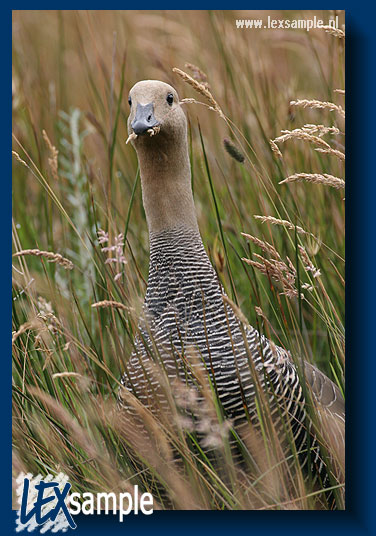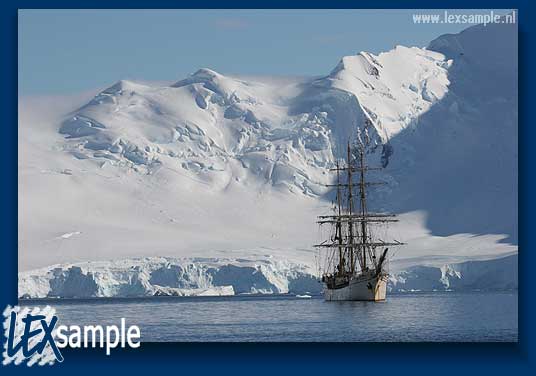LEXsample :: Antarctica
From Tierra del Fuego by way of the Antarctic Peninsula to Cape Town
Table of contents
Introduction
 The following pages present a selection of birds and landscapes, photographs that I took in the Spring of 2005 during a seven week sailing trip.
The city of Ushuaia (Tierra del Fuego, Argentinia) was the starting point of this trip, which brought us to the Antartic Peninsula and then on to the islands of South Georgia and Tristan da Cunha; it ended in Cape Town (South Africa).
In the course of these seven weeks we sailed about 10,000 km (the motor was also used whenever there was not enough wind).
The following pages present a selection of birds and landscapes, photographs that I took in the Spring of 2005 during a seven week sailing trip.
The city of Ushuaia (Tierra del Fuego, Argentinia) was the starting point of this trip, which brought us to the Antartic Peninsula and then on to the islands of South Georgia and Tristan da Cunha; it ended in Cape Town (South Africa).
In the course of these seven weeks we sailed about 10,000 km (the motor was also used whenever there was not enough wind).
Ushuaia and the National Park of Tierra del Fuego
Before we boarded the ship, we spent a couple of days visiting the National Park of Tierra del Fuego, which is easy to reach from Ushuaia.
The first pages show photographs from both the nature reserve as well as the area around the city itself.
We spent four days in all, but next time it's certainly worthwhile to stay a bit longer.
The sailing trip
Built in 1911, the tall ship Bark Europa would be our home out on the open oceans. It is quite different from the majority of tourist ships that, reinforced against the ice, usually visit the Antarctic Peninsula.
The ship itself is a beauty to look at. The crew expects all passengers ('trainees') to help out with all the work and to be on watch during the daytime and nighttime.
For people like me, who enjoy the natural scenery, there was too much emphasis on the sailing itself, and so there wasn't always enough opportunity to enjoy the rest.
It should also be noted that a sailing ship depends much more on weather conditions than a motor ship; so quite a few items on the program that we were promised had to be skipped.
Still, it has been a unforgettable experience.

About the photographs
Compared to the bigger cruise ships, the tall ship offered some surprising opportunities to take pictures of seabirds: on the one hand because of its slower speed, on the other hand because of the low point of view (on deck, you are not too far away from the sea surface). You'll see the results on the next pages.
It isn't easy taking pictures on a ship that is constantly moving, with sometimes a strong wind blowing or with sea water spraying from unexpected corners, with dull-coloured birds flying far away to suddenly disappear out of focus behind gigantic waves - that is, if you had them in focus to start with! And finally you have to try to keep yourself upright ... But these are all the ingredients for an oceanic sea trip. The hourglass dolphins, were enjoying themselves most when the sea was roughest, jumping and riding the waves. No opportunity to take pictures at these times, but plenty of opportunity to watch and enjoy the show.
Fortunately sufficient good opportunities for taking good photographs remained. Some of the photographs shown here have been cropped a bit: a 'cut-off' left upper corner will tell you which ones were cropped. All other photographs are displayed at their original size.
Audio recordings
 I managed to record some bird species on audio. Wherever you see this icon, you can click on it to listen to the recording.
I managed to record some bird species on audio. Wherever you see this icon, you can click on it to listen to the recording.
Save The Albatross
BirdLife is the worldwide organisation for the conservation of birds. BirdLife's Save The Albatross focusses on the 21 species of Albatrosses that globally exist, 19 of which are threatened.
I am happy to give my support to this campaign, and hope you will give a bit of support too. Visit the new RSPB/BirdLife Save the Albatross web site at www.savethealbatross.net.

More information on Albatrosses can be found on the page Antarctica links
Albatros postcards and poster
 An Albatross poster and six LEXsample photographs with Albatrosses and Petrels have been published as a postcard, in collaboration with BirdLife International.
These articles can be ordered from the LEXsample shop (open shop menu on the left).
An Albatross poster and six LEXsample photographs with Albatrosses and Petrels have been published as a postcard, in collaboration with BirdLife International.
These articles can be ordered from the LEXsample shop (open shop menu on the left).
Acknowledgement
Thanks to Jolande for helping me out with the descriptions that accompany each photograph and for the translations into English.
 Next
© LEXsample 2005
Next
© LEXsample 2005

 The following pages present a selection of birds and landscapes, photographs that I took in the Spring of 2005 during a seven week sailing trip.
The city of Ushuaia (Tierra del Fuego, Argentinia) was the starting point of this trip, which brought us to the Antartic Peninsula and then on to the islands of South Georgia and Tristan da Cunha; it ended in Cape Town (South Africa).
In the course of these seven weeks we sailed about 10,000 km (the motor was also used whenever there was not enough wind).
The following pages present a selection of birds and landscapes, photographs that I took in the Spring of 2005 during a seven week sailing trip.
The city of Ushuaia (Tierra del Fuego, Argentinia) was the starting point of this trip, which brought us to the Antartic Peninsula and then on to the islands of South Georgia and Tristan da Cunha; it ended in Cape Town (South Africa).
In the course of these seven weeks we sailed about 10,000 km (the motor was also used whenever there was not enough wind).

 I managed to record some bird species on audio. Wherever you see this icon, you can click on it to listen to the recording.
I managed to record some bird species on audio. Wherever you see this icon, you can click on it to listen to the recording.

 An Albatross poster and six LEXsample photographs with Albatrosses and Petrels have been published as a postcard, in collaboration with BirdLife International.
These articles can be ordered from the LEXsample shop (open shop menu on the left).
An Albatross poster and six LEXsample photographs with Albatrosses and Petrels have been published as a postcard, in collaboration with BirdLife International.
These articles can be ordered from the LEXsample shop (open shop menu on the left).
 Next
Next